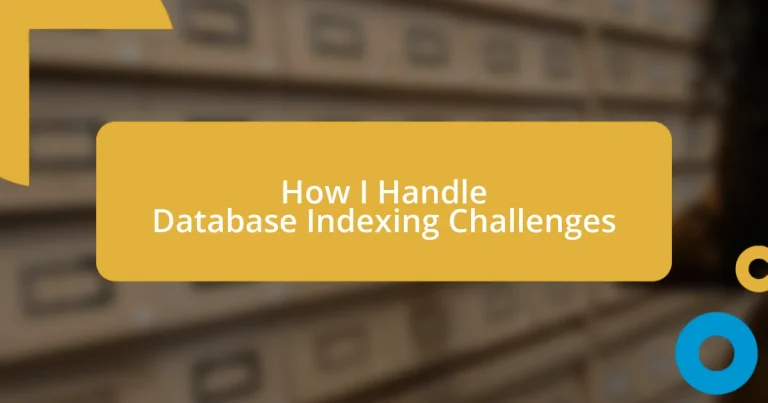Key takeaways:
- Database indexing enhances data retrieval efficiency, comparable to a book’s table of contents, but requires careful balance to avoid over-indexing and related performance issues.
- Regular index assessments and maintenance, including monitoring usage and fragmentation, are essential for optimizing database performance and adapting to changing workloads.
- Utilizing tools like SQL Server Management Studio and engaging with stakeholders can provide valuable insights for continuous improvement in indexing strategies.
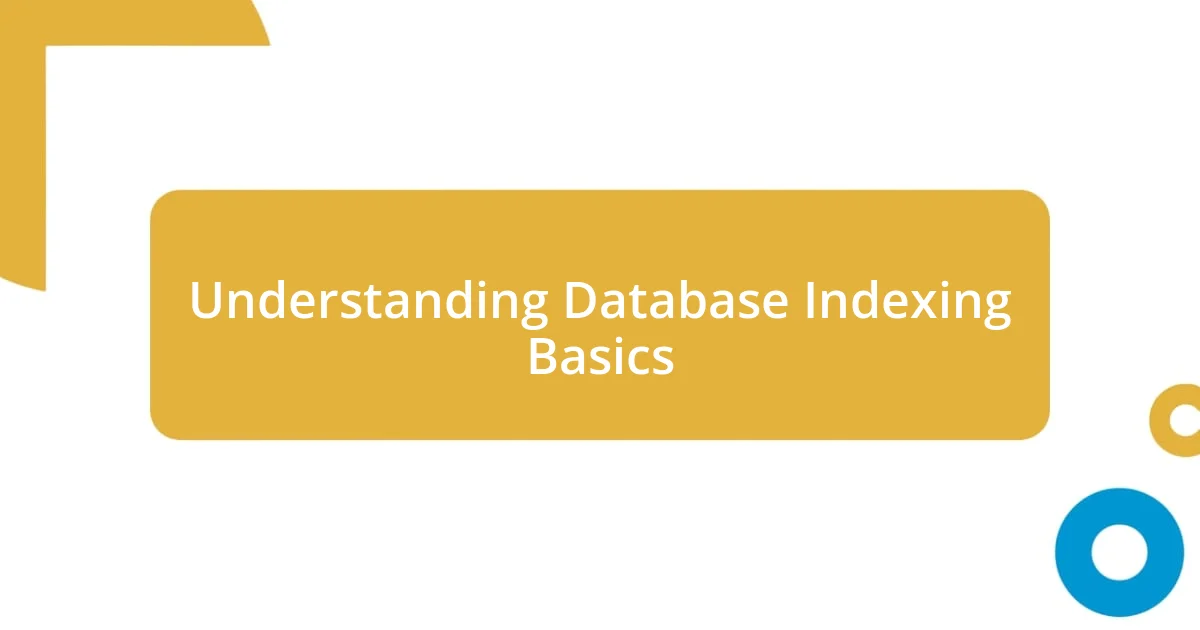
Understanding Database Indexing Basics
When I first encountered database indexing, I was taken aback by its potential to significantly speed up data retrieval processes. Think of an index like a book’s table of contents: it helps you quickly locate the information you need without sifting through every page. This realization was a game-changer for me in managing large datasets.
The concept of indexing revolves around creating a data structure that improves the efficiency of searches on a database. I often find myself picturing it like a filing system in an office; without proper labels and organization, finding a specific document can feel like searching for a needle in a haystack. Have you ever spent too long searching for something important? That’s the frustration indexing aims to eliminate.
It’s also essential to remember that not all queries benefit equally from indexing, and understanding the types of indexes—like single-column versus multi-column—can shape how effectively we approach database management. During my work on various projects, I’ve learned the hard way that over-indexing can lead to increased overhead, similar to hoarding too many supplies in a closet. Balancing efficiency and performance is crucial for any successful database strategy.
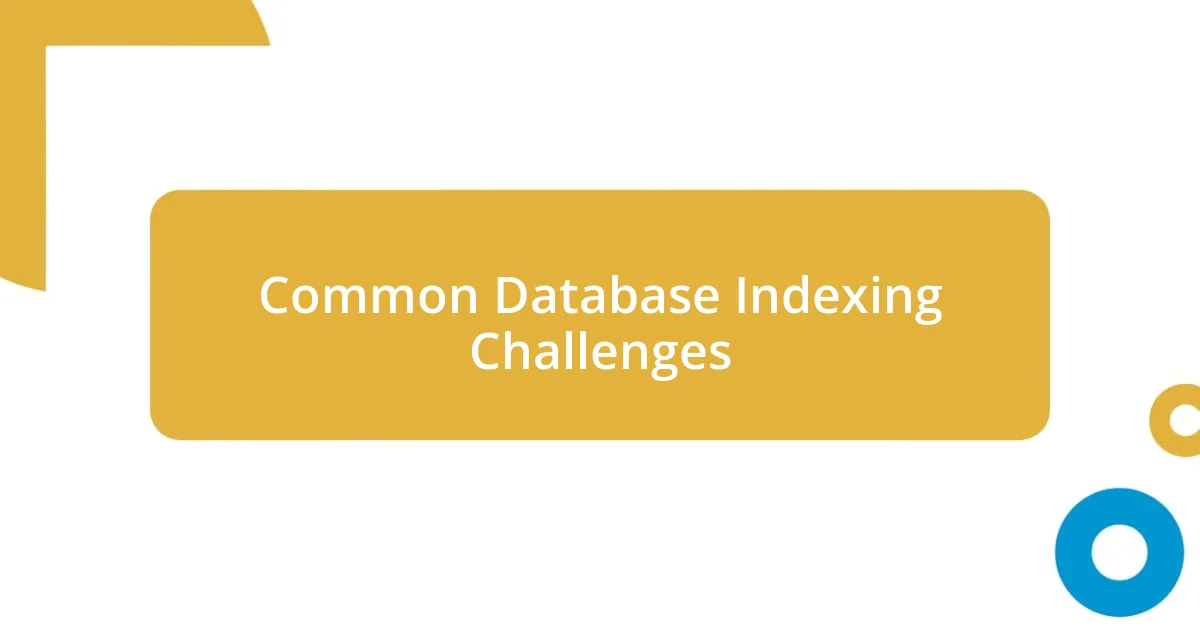
Common Database Indexing Challenges
Database indexing challenges come in various forms, and I’ve faced several of them. For instance, one common issue is index fragmentation. Over time, as data is inserted, updated, and deleted, the index can become less efficient, which leads to slower query performance. I once worked on a project where we neglected this aspect, thinking it wouldn’t matter much. But as the database grew, we realized our queries were taking forever to complete, and it felt like driving a car with a clogged fuel filter—frustrating and definitely not the smooth ride we expected.
Here are some other common indexing challenges that I’ve encountered:
- Over-indexing: Creating too many indexes can consume significant storage and degrade performance during data modifications.
- Under-indexing: Insufficient indexing can lead to excessive table scans, resulting in longer query times.
- Index Maintenance: Regular maintenance is required to keep indexes efficient, which can be time-consuming and often gets overlooked.
- Choosing the Wrong Index Type: Misunderstanding the differences between unique, composite, or full-text indexes can lead to ineffective strategies.
- Obsolete Indexes: Old indexes that are no longer used can clutter the database and waste resources.
Each of these challenges has taught me valuable lessons about maintaining an efficient database system. They remind me that, much like tending a garden, regular care and attention are necessary to keep everything thriving.
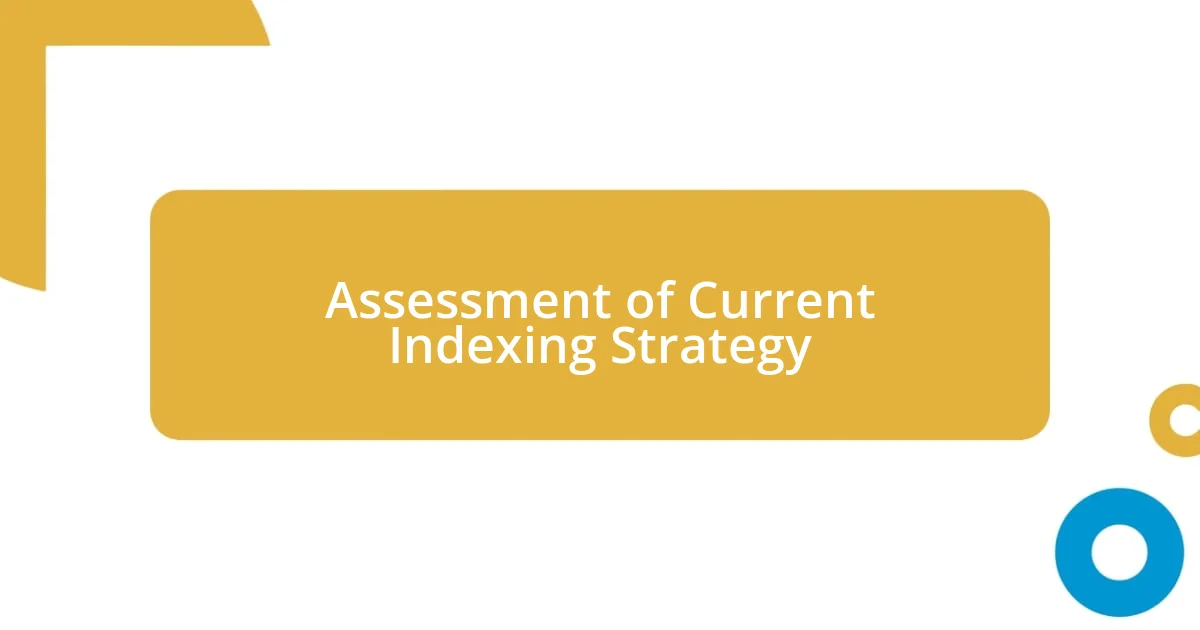
Assessment of Current Indexing Strategy
When assessing my current indexing strategy, I often find it helpful to revisit the core objectives behind each index. For instance, I once compiled a comprehensive list of queries that had significant performance challenges. By analyzing their execution plans, I uncovered that some indexes were supporting multiple queries, while others were mostly idle. This realization was akin to unearthing a hidden treasure—refining my indexing strategy significantly improved our system’s performance and reduced unnecessary overhead.
Another important aspect is the data distribution and query patterns over time. In one project, I noticed that the workload shifted as user behavior changed, which rendered some of our existing indexes practically useless. It felt a bit like redesigning a room in your house after realizing that the furniture layout just isn’t working anymore. By staying updated on how our application’s usage evolved, I could adapt the indexing strategy accordingly, ensuring a more responsive and efficient database experience.
As I conduct this assessment, I also weigh the performance impact of each index against its maintenance cost. Reflecting on past experiences, I recall a time when I was hesitant to drop an obsolete index—fearful of messing with the established system. However, once I overcame that hesitation and removed it, I witnessed an immediate uplift in query speeds. It was a valuable lesson in the importance of regularly reviewing and adjusting our strategies for optimal efficiency.
| Index Type | Performance Impact |
|---|---|
| Single-column | Fast for specific queries |
| Multi-column | Better for complex queries |
| Full-text | Great for text searches |
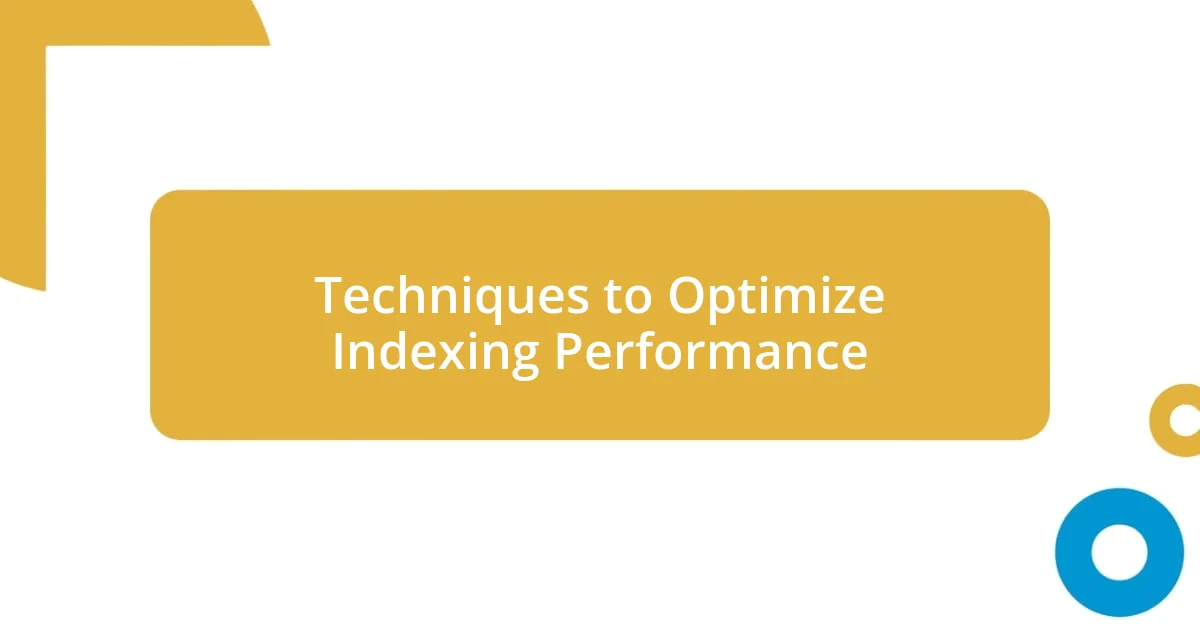
Techniques to Optimize Indexing Performance
One technique I often rely on is index rebuilding and reorganizing, which can work wonders for reducing fragmentation. I remember a situation where our queries were running so sluggishly that they were barely usable. After dedicating an afternoon to rebuilding our indexes, it was like flipping a switch—suddenly, everything ran smoothly again. Have you ever noticed how a well-organized closet makes it easier to find what you need? That’s the power of maintaining tidy indexes.
Another method I incorporate is leveraging SQL Server’s statistics to optimize performance. By updating these statistics regularly, I can ensure that the query optimizer has the most accurate data. There was a time I overlooked this, and our database performance took a hit because the optimizer kept making suboptimal choices. It serves as a reminder that, much like keeping track of recent expenses, monitoring statistics is essential to make informed decisions that directly impact efficiency.
I’ve also found that periodic index reviews can significantly help refine the indexing strategy. When I went through this process last, I was shocked by how many redundant indexes we had that were only adding to our maintenance woes. It felt like spring cleaning—clearing out the old clutter not only freed up resources but also enhanced our overall system performance. Have you ever taken the time to step back and assess what’s truly necessary? It can lead to some surprising and beneficial adjustments.
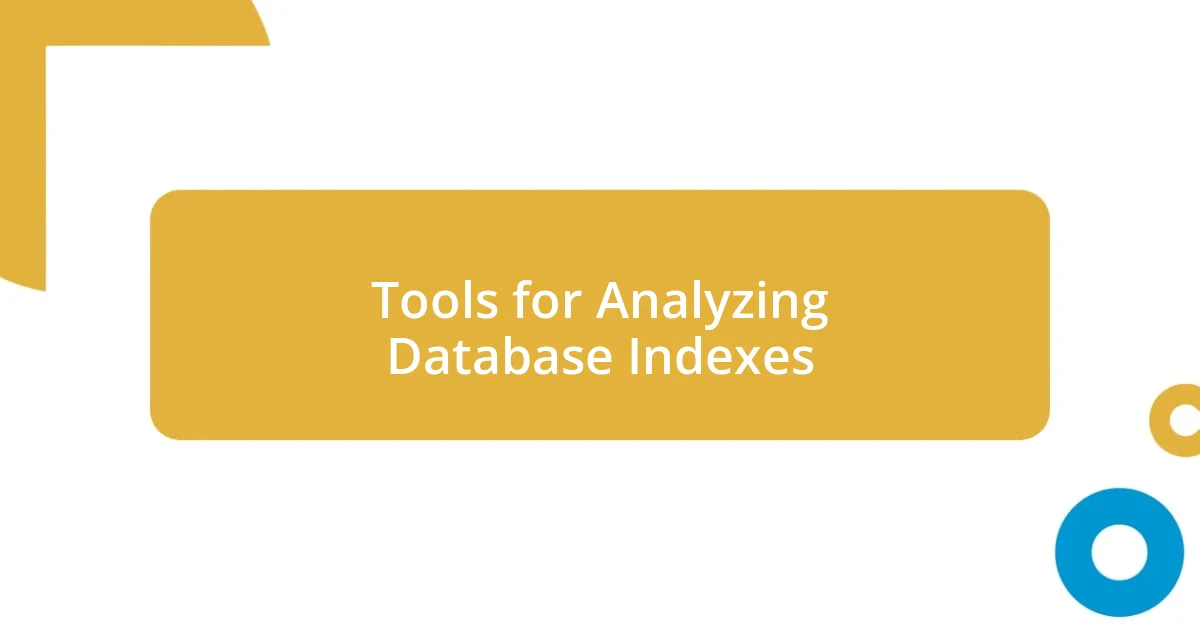
Tools for Analyzing Database Indexes
When it comes to analyzing database indexes, I find tools like SQL Server Management Studio (SSMS) indispensable. I remember the first time I used the Database Engine Tuning Advisor; it was like having a personal coach guiding me through performance optimizations. By simply feeding SQL queries into the tool, I received tailored indexing recommendations that dramatically improved response times. It’s an incredible feeling to watch system performance soar when you implement these suggestions.
Another powerful tool in my toolkit is the Query Performance Insight in Azure SQL Database. Just recently, I had a project that was bogged down by inefficiencies. By closely monitoring slow-running queries with this tool, I discovered which indexes were underperforming or completely disregarded, saving time and resources. This experience reinforced a valuable lesson: sometimes, you need to shine a light on the shadows to see what’s really going on.
I also frequently utilize third-party tools like SolarWinds Database Performance Analyzer. This software provides deep insights into index usage and can even alert you to anomalies in real-time. I recall a near panic moment when an index I thought was efficient turned out to be a sluggish drag on performance. Thanks to the alerts, I was able to address the problem before users even noticed a slowdown. It’s reassuring to rely on tools that help me stay one step ahead of potential issues.
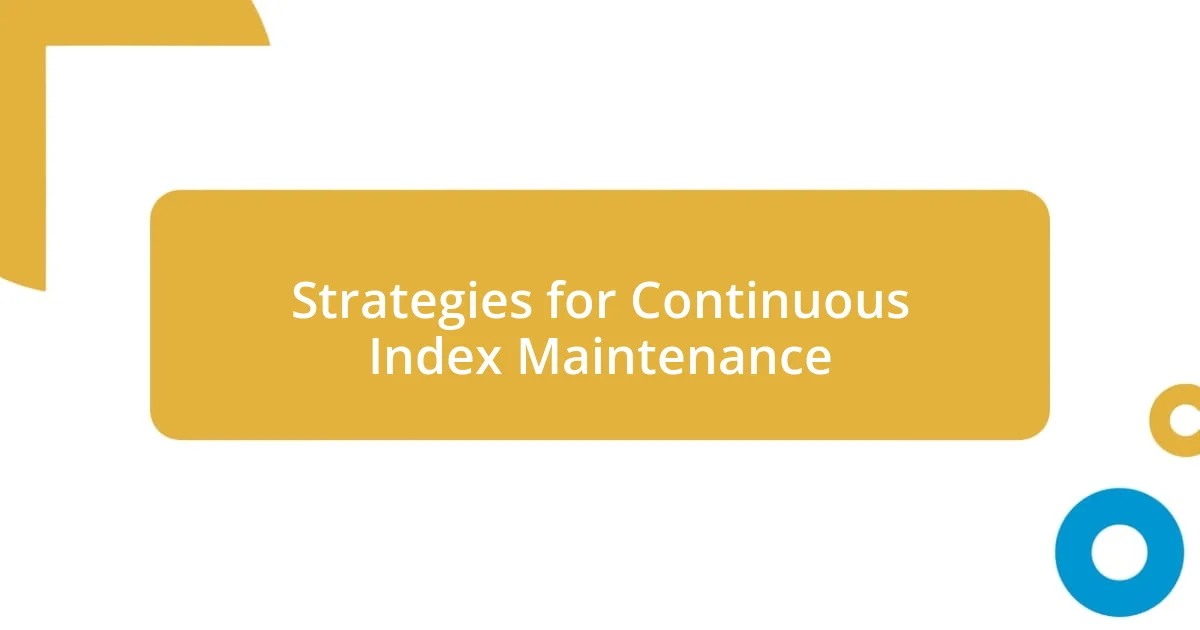
Strategies for Continuous Index Maintenance
Maintaining indexes is a continuous journey, and one strategy that has served me well is automated index maintenance. I’ve set up jobs to perform routine checks and maintenance tasks during off-peak hours, ensuring our databases remain efficient without disrupting daily operations. One night, as I monitored the automation, I felt a sense of relief; knowing that I could focus on other priorities while our indexing was being handled was incredibly freeing. Have you ever experienced the comfort that comes from a well-oiled machine working behind the scenes?
In addition, I often schedule indexes for a quick health check. During one particularly busy season, I found myself regularly checking index fragmentation levels—like periodically testing the brakes on a car. One time, I discovered a critical index that had exceeded the safe threshold, prompting immediate action. This proactive approach not only prevented potential performance issues but also fostered a culture of vigilance in our team. Isn’t it reassuring to know that a little diligence now can save a lot of headaches later?
Lastly, I can’t emphasize enough the importance of engaging with stakeholders on index performance concerns. One memorable experience involved a conversation with our sales team, who shared insights about how slow reports were impacting their productivity. By understanding their perspective, I was able to adjust our indexing strategy to better meet their needs, leading to faster query responses. It’s remarkable how collaboration can illuminate blind spots in our indexing approach, don’t you think? Working together often results in solutions that enhance overall database performance.












